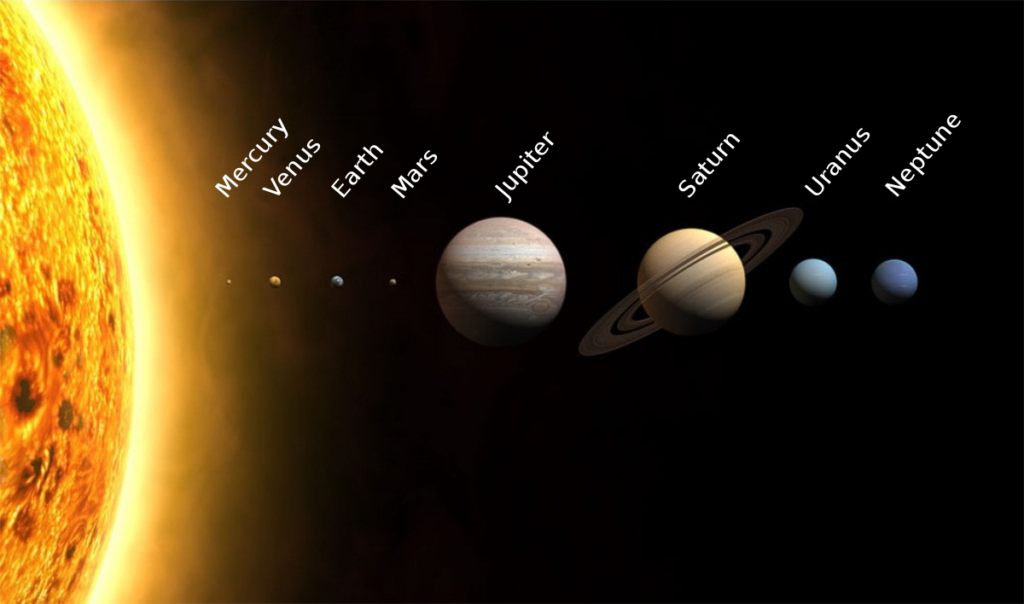Back to: BASIC SCIENCE TECHNOLOGY JSS 1
Welcome to class!
In today’s class, we will be talking about the earth in space. Enjoy the class!
Earth in Space

The solar system
The planet earth, on which we live, is moving through space all the time. It is going around the sun. In doing this it carries us all through space. The earth travels through space but we do not realize this because the air around the earth is carried along with it. The sun together with all the bodies which revolves around it makes up the solar system.
The solar system consists of the sun, nine planets and their moons along with dwarf planets, comets and asteroids, which revolve around the sun. The Solar System is the gravitationally bound system of the Sun and the objects that orbit it, either directly or indirectly of the objects that orbit the Sun directly, the largest are the eight planets, with the remainder being smaller objects, the dwarf planets and small Solar System bodies.
The solar system is divided into inner and outer parts. The inner part contains the Sun, Mercury, Venus, Earth and Mars while the outer part contains Jupiter, Saturn, Uranus and Neptune. The two parts are demarcated by the asteroid belt.
The nine planet
Sun:
The Sun is, at present, about 70% hydrogen and 28% helium by mass, everything else (“metals”) amounts to less than 2%. This changes slowly over time as the Sun converts hydrogen to helium in its core. The Sun’s magnetic field is very strong (by terrestrial standards) and very complicated. Its magnetosphere (also known as the heliosphere) extends well beyond Pluto.
The Sun is the heart of our solar system and its gravity is what keeps every planet and particle in orbit. This yellow dwarf star is just one of the billions like it across the Milky Way galaxy. Our Sun is a normal main-sequence G2 star, one of more than 100 billion stars in our galaxy.
Mercury:
The planet closest to the Sun, Mercury is the smallest and fastest planet in the solar system; whipping around the Sun every 88 Earth days. Mercury is the closest planet to the Sun but, perhaps surprisingly, it does not have the highest temperatures.
Venus:
It is the second planet from the Sun and the sixth-largest. Together with Mercury, they are the only planets without a satellite, even though Mercury is closer to the sun, Venus is the hottest planet.
Earth:
The place we call home, Earth is the third rock from the sun and the only planet with known life on it, and lots of it too! Earth is the third planet from the Sun and the fifth largest planet in the Solar System with the highest density. It is currently the only known location where life is present.
Mars:
It is the fourth planet from the Sun and the second-smallest planet with a thin atmosphere, having the surface features reminiscent both of the impact craters of the Moon, and the valleys, deserts and polar ice caps of Earth. It is the most widely searched planet for life.
Jupiter:
It is named after the principal Roman god, the equivalent of the Greek god Zeus. Jupiter is one of the five visible planets (Mercury, Venus, Mars, Saturn), being the fifth most distant from the Sun at an average distance of 5.2 AU, its closest approach is at 4.9 AU and at its farthest 5.4 AU.
Saturn:
It is the sixth planet from the sun, with the largest planetary rings in the Solar System. It is the second-largest planet after Jupiter, and recently, with many other moons being discovered, it surpassed the number of Jupiter’s moons and is now considered the planet with the most numerous satellites.
Uranus:
It is the seventh planet from the Sun, around 1.8 billion miles or 2.9 billion kilometres distance away. … Venus also does this but Uranus is the only known planet to rotate on its side. It takes Uranus 84 years to complete an orbit of the Sun, the longest from all the planets in the solar system.
Neptune:
It is the fourth largest and the farthest planet of the Solar System with the most powerful wind speeds out of all the planets. It is the smallest of the gas giants and is the first planet to be discovered by mathematical predictions in 1846.
Pluto:
It is the smallest planet and the farthest planet from the sun.
In our next class, we will be talking more about the Earth in Space. We hope you enjoyed the class.
Should you have any further question, feel free to ask in the comment section below and trust us to respond as soon as possible.

How come Uranus is the slowest when Neptune and Pluto are farther